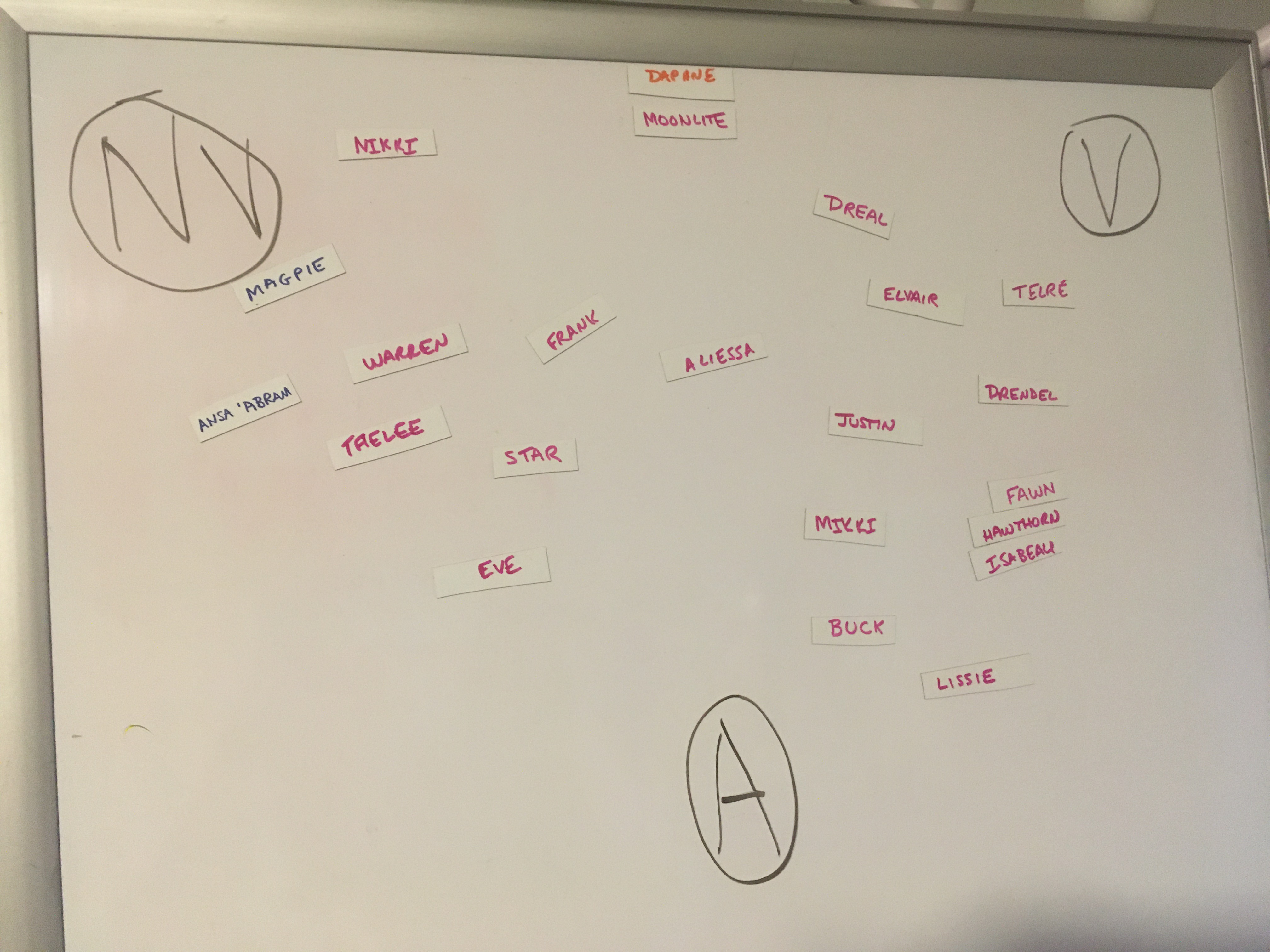Self-MapExercises
The articles on various types of headmaps and headmap technology New.
Start with a List
The simple-seeming act of listing your headmates can be very liberating in itself.
If you don't know names, try to keep the labels you use respectful and say things like "the girl with red hair" "the guy who seems angry" etc. Not "The angry guy" "The Red Girl".
We speak from experience ;) More about that in Naming Residents and Naming Names. Respectful labels are just a part of being compassionate and not judging people by their behaviors or appearance.
There's an example of "pretty much just a list" here. (Note that what had started as a straight list later got sectioned into our subsystems, and each name that is a link links to more info about that headmate.)
List with Details
What types of details do folk put on their "list with details"? Here's some ideas, but try not to drive yourselves to distraction with logging details; only log what is important to you and your headmates, especially if you're rapidly meeting new headmates. You can end up spending more time writing down details than actually meeting folk or living life.
- Mini biography
- Alternate names (dropped/lost/old names, nicknames, etc.)
- Age - gender - orientation - pronouns
- Body age of first appearance or date (some use this as a headmate's birthday)
- Species, race, type
- Roles - external or internal
- Origins - introject, fictive, construct, walk-in, etc.
- Notable traits or tells
- Skills or interests
- Song or anthems
- Favorite things (colors, foods, etc.)
- and so on…
The Crisses Who's Who list links to a more detailed "bio" for some of the headmates — alternate names, links to folk they're connected to, a little of their past history, perhaps their age, gender/pronouns, favorite song(s), etc. are on those auxiliary pages. So for example here's Erin's page. It includes some art someone in here did of her, and a profile picture, some notes about her and some by her, etc.
Heat-Maps
We call these heat maps because you play an intuitive or sensory game of hot & cold ("you're getting hotter!" "you're freezing cold!") with yourselves similar to the intuition-building Litmus Test to create these maps. So these maps can be used to depict various types of relationships that show degrees of connectivity or similarity between system members.
You can use these in lieu of inner world maps for a variety of selves-help exercises. For example, mapping how “close” and “far” folk “feel” to each other or communication ability between system members.
What do we mean by “close” or “far” — whatever works for y’all. Emotionally connected to each other, a sense of proximity or distance internally, ability to sense or communicate with each other, age or gender relationships, levels or degrees of coconsciousness, frequency of fronting, etc. If there’s any factor that you can relate your map around, use it to create your map; it’s an exercise in “feeling out” any type of relationship or qualities of your system mates.
To start, you can "sketch" this out with game pieces or slips of paper with names first to “feel out” what “works”. Then you can document or archive the "map" by either photographing it or drawing a map (on paper or electronically) of these relationships with shapes and/or labels for each headmate. If you use colors instead of names, you can create artwork that no one but you will understand and display it somewhere to remind you of everyone in your system.
Many types of maps use this rudimentary skill of "Heat Mapping" to create more complicated diagrams and maps.
Example heat map Communication Styles —> NV = non-verbal (sign, emote, body language), V = verbal (words, text, writing), A = audial (speaking, hearing, sound). We mapped by "feel" where each headmate would go in this continuum of styles of communication. So, some examples on the map: Magpie is the closest to NV, she is almost entirely non-verbal. Daphne & Moonlite are both verbal (as in they use words) and non-verbal (emotes, signs, etc.), but very far away from Audial. Buck & Lissie tend more towards audial as in they like to communicate vocally, and both are verbal as in they use their words, so they lean towards the verbal side of audial. Aliessa is pretty balanced, so she's in the middle, but Frank who likes to draw & creates comics, leans a little more towards NV. These may be accurate today but change tomorrow. It's all done by feel/instinct or opinion, it's not "factual" or definite.

